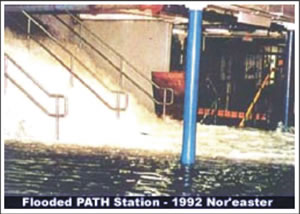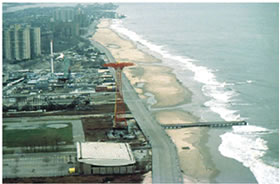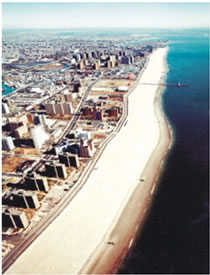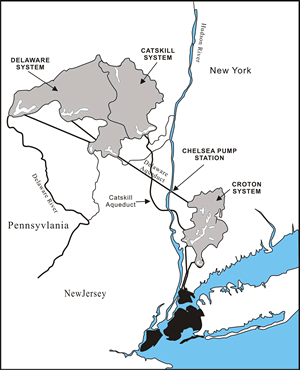|
|
 |  | 
| Print this Brief |
| What are the projected costs of climate change in the regionís coastal communities and coastal environments? |
| |
Key Points
The effects of climate change on the tri-state New York metropolitan area are likely to be costly. The region is already in the process of rebuilding its aging basic infrastructure at costs approaching about $100 billion per decade. Sea-level rise and land subsidence are projected to lead to additional infrastructure losses from coastal floods and to accelerate coastal erosion; the costs associated with these losses may stress the regional economy.
 |
| Figure
1. Flooded PATH station in December, 1992.
Source: NYC Office of Emergency Management. |
|
Projected Damages to Infrastructure
As sea level rises, infrastructure losses from coastal
floods will increase. The expected annual loss from
coastal storms is around $100 to $200 million
per year. This loss is small enough to be absorbed
by the region’s $1 trillion economy. However,
losses do not occur with an annual periodicity. Rather,
they occur during infrequent extreme events such
as the Nor’easter of 1992 (see Question 2D).
Figure 1 depicts a flooded PATH station in Hoboken,
NJ during that event. Extreme events have the potential
to cause the loss of tens and potentially hundreds
of billions of dollars. Such large losses could deprive
the economy of a large fraction of the gross regional
product and negatively affect insurers, policyholders
and the noninsured.
 |
| Figure
2. Dilapidated sea wall. Source: Gornitz,
Sea Level Rise and Coasts, in Climate Change
and a Global City, 2001. |
| Strategies for coping with coastal erosion and
flood damages associated with sea-level rise include
defending the shoreline by means of protective structures,
beach restoration, and ultimately, retreat. Even at present rates of sea-level
rise and land subsidence, most of the shoreline of the New York metropolitan
region is eroding (Figure 2). In response, existing hard structures – seawalls,
groins, jetties, breakwaters – may need to be strengthened and elevated
repeatedly and beaches will require additional sand replenishment. The increased
costs of retrofitting existing structures or armoring selected portions of the
coast may be viable in areas with a high population density or in areas with
a high property-value, such as Manhattan, NY or Jersey City/Hoboken, NJ. In some
locations, affluent shore property owners or seaside communities may also be
willing to incur the additional expenses to save their beaches, as for example
in Southampton and Easthampton, Long Island. However, other stretches of the
coastline may not be able to command the necessary resources.
 |
| Figure
3a. Coney Island before beach nourishment
in December, 1992. Source:
U.S. Army Corps of Engineers. |
| Projected Damages from Erosion
Over 70% of the world’s sandy beaches are
retreating. In the New York metropolitan region,
beaches and barrier islands are narrowing or shifting
landward, in part due to ongoing sea-level rise and
land subsidence. Accelerated sea-level rise may intensify
the rate and extent of coastal erosion. Many beaches
are artificially maintained by the U.S. Army Corps
of Engineers. They have spent a cumulative total
of $2.4 billion nationally and $884 million within
the tri-state region on beach nourishment projects
 |
| Figure
3b. Coney Island after beach nourishment
in March, 1995. Source:
U.S. Army Corps of Engineers. |
| since the 1920s (Figures 3a, 3b). Over half a billion
dollars have been spent in New York State alone,
the largest
expenditure for any single state.
It is estimated that by the 2080s sand replenishment
and associated costs will grow between 5 to 26%
due to climate change. The amount of sand needed
for
replenishment projects is expected to increase
in the future and the costs associated with beach
nourishment
may make retreat an appropriate option. Retreat,
or pulling back from the shore, may be most feasible
in areas of lower population densities or lower
land values, or in high-risk areas subject to repeated
storm damage.
Projected Threats to the Water Supply
Increased sea-level rise could affect the operation
of the Chelsea Pump Station, which is located on
the east bank of the Hudson River and has a present
capacity of 100 million gallons per day (mgd). Increased
sea-level rise would bring
 |
| Figure
4. New York City water supply. Source:
New York City Department of Environmental
Protection (NYCDEP). |
|
increased salinity, exacerbating
a fundamental conflict, which is that the station
is most needed during periods of drought, which
is precisely the time when the salt front moves upstream
(Figure 4).
A study of the costs associated with increasing
the withdrawal capacity of the Chelsea Pump Station
system indicated that withdrawing
an additional 100 mgd of water could
cost $28 million, and an additional 200 mgd of water
would cost $86 million; the costs
with filtration would be $223.5 million and $327.9
million.
|
References:
Jacob, K.H., N. Edelblum, and J. Arnold (2001) Infrastructure.
In Rosenzweig, C. and W.D. Solecki, (eds.), "Climate
Change and a Global City: An Assessment of the Metropolitan
East Coast Region" (pp. 21 – 46) Columbia
Earth Institute, New York, 210 pp.
Gornitz, V. (2001) Sea-Level Rise and Coasts. In
Rosenzweig, C. and W.D. Solecki, (eds.), "Climate
Change and a Global
City: An Assessment of the Metropolitan East Coast Region" (pp.
21 – 46) Columbia Earth Institute, New York,
210 pp.
Major, D. and R. Goldberg (2001) Water supply. In
Rosenzweig, C. and W.D. Solecki, (eds.), "Climate
Change and a Global
City: An Assessment of the Metropolitan East Coast Region" (pp.
21 – 46) Columbia Earth Institute, New York,
210 pp.
Malcolm Pirnie Inc. (1986) "Engineering Alternatives
for Increasing the Rate of Withdrawal from the Hudson
River
from 100 MGD to 200 MGD to 300 MGD." Prepared for the
City of New York, Department of Environmental Protection,
Bureau of Water Supply, October.
National Research Council (1987) "Responding to
Changes in Sea Level: Engineering Implications."
National Academy Press, Washington, D.C., 148 pp.
National Research Council
(1990) "Managing Coastal Erosion." National
Academy Press, Washington,
D.C., 182 pp. National Research Council (1995) "Beach Nourishment
and Protection." National Academy Press, Washington,
D.C.,
334 pp.
Rosenzweig, C. and W.D. Solecki (Eds.). 2001. "Climate
Change and a Global City: The
Potential Consequences of Climate Variability and Change – Metro
East Coast (MEC)." Report for the U.S. Global Change
Research Program, National Assessment of the Potential
Consequences
of Climate Variability and Change for the United States,
Columbia Earth Institute, New York. 224 pp.
Zimmerman, R. and M. Cusker (2001) Institutional
Decision-Making. In Rosenzweig, C. and W.D. Solecki,
(eds.), "Climate Change
and a Global City: An Assessment of the Metropolitan
East Coast Region" (pp. 21 – 46) Columbia
Earth Institute, New York, 210 pp.
Related Resources:
Print version (factsheet pdf)
|
|
 |
 |

